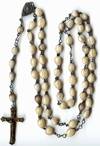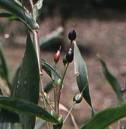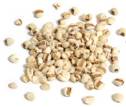News
COIX SEEDS : FOOD AND MEDICINE
Update: 7/27/2015y Subhuti Dharmananda, Ph.D., Institute for Traditional Medicine, Portland, Oregon
 Coix is the common name for the Chinese medicinal material Coix lacryma-jobi seed. The entire coix plant and its seed pod are commonly called Job’s Tears, which is the English equivalent of the Latin species name (lacryma = tears): the seed pod often has a tear drop appearance. Linnaeus gave the botanical name in 1753, relying upon an existing popular reference for the tear shaped pods to the Book of Job (e.g., Job said: “before God my eyes drop tears”); it has also been called St. Mary’s tears. World-wide, this plant is best known for those pods (pericarps), which have a hole naturally occurring at each end, making them a useful source of beads for stringing. One popular application is making rosaries, as the beads are especially resistant to damage by moisture and have a valued symbolism of tears.
Coix is the common name for the Chinese medicinal material Coix lacryma-jobi seed. The entire coix plant and its seed pod are commonly called Job’s Tears, which is the English equivalent of the Latin species name (lacryma = tears): the seed pod often has a tear drop appearance. Linnaeus gave the botanical name in 1753, relying upon an existing popular reference for the tear shaped pods to the Book of Job (e.g., Job said: “before God my eyes drop tears”); it has also been called St. Mary’s tears. World-wide, this plant is best known for those pods (pericarps), which have a hole naturally occurring at each end, making them a useful source of beads for stringing. One popular application is making rosaries, as the beads are especially resistant to damage by moisture and have a valued symbolism of tears.

 The seeds (caryopses) of Coix lacryma-jobi are used as a source of food, sometimes called adlay seed; a variety of the plant (var. ma-yuen = var. adlay) having relatively softer pods is relied upon for this use, while hard shell pods are used for beads. The plant is of the grass family that produces several edible grains such as wheat, corn, millet, and barley, and though more closely related to corn (maize), the coix seed has a size and appearance approximating that of barley, and has been referred to as coix barley. Most commonly, the food material is polished (the brown hull is removed) and therefore described as “pearl barley” (however, the term pearl barley is equally applied to ordinary barley that has been polished, so this is not a specific designation for coix). Coix barley has a rather strong taste among the food grains (though considered tasteless from the herbal perspective), similar to barley; coix is usually consumed in relatively small quantities (about 30 grams dried seed per serving) mixed with glutinous rice (“sticky rice”) or mixed with an equal proportion of brown sugar. Coix has a good protein yield compared to rice, up to double; more than half the coix seed is starch. This grain is native to Southeast Asia, ranging from India (its likely point of origin) through Malaysia to China; it is now cultivated elsewhere. Its use as a food in Asia, both for humans and animals, declined after the introduction of other grain crops with higher yields, such as corn and sorghum.
The seeds (caryopses) of Coix lacryma-jobi are used as a source of food, sometimes called adlay seed; a variety of the plant (var. ma-yuen = var. adlay) having relatively softer pods is relied upon for this use, while hard shell pods are used for beads. The plant is of the grass family that produces several edible grains such as wheat, corn, millet, and barley, and though more closely related to corn (maize), the coix seed has a size and appearance approximating that of barley, and has been referred to as coix barley. Most commonly, the food material is polished (the brown hull is removed) and therefore described as “pearl barley” (however, the term pearl barley is equally applied to ordinary barley that has been polished, so this is not a specific designation for coix). Coix barley has a rather strong taste among the food grains (though considered tasteless from the herbal perspective), similar to barley; coix is usually consumed in relatively small quantities (about 30 grams dried seed per serving) mixed with glutinous rice (“sticky rice”) or mixed with an equal proportion of brown sugar. Coix has a good protein yield compared to rice, up to double; more than half the coix seed is starch. This grain is native to Southeast Asia, ranging from India (its likely point of origin) through Malaysia to China; it is now cultivated elsewhere. Its use as a food in Asia, both for humans and animals, declined after the introduction of other grain crops with higher yields, such as corn and sorghum.
The seed used as a Chinese medicinal ingredient is called yiyiren 薏苡仁 (ren = seed; two characters pronounced yi, with different tones, together designate this specific plant); in common parlance, it is simply called yiren or yimi (the yi grain).
Coix was first mentioned in the Shennong Bencao Jing (ca 100 A.D.), mainly for use in treating people with stiffness attributed to inability to contract or stretch the sinews and for “bi syndrome” due to wind-damp (1). In the Jingui Yaolue (ca 200 A.D.), the combination of coix and aconite was one of the recommended treatments for a syndrome of “thoracic paralysis (2).” The use of coix for stiffness in the limbs (inability to stretch or bend) is preserved to this day in Japanese practice (Kampo) with Yiyiren Tang (Coix Combination), first introduced by Huang Fuzhong in his book Mingyi Zhizhang (1502 A.D.) and brought to Japan during the major transfer of the Chinese herb system that took place in the 16th and 17th centuries (3–5). In a recent publication about simple remedies (6), a treatment for lumbar pain and stiffness due to myofibrositis was described: 60 grams coix plus 30 grams white atractylodes (baizhu), decocted and taken as a one day dose. These are two of the important ingredients of Coix Combination (which also contains ma-huang, tang-kuei, cinnamon twig, peony, and licorice). Coix Combination is known among Kampo practitioners as a remedy for early stage and mild forms of arthritis (5). In fact, one of the first Chinese herb formulas marketed in America direct to consumers was Coix Combination, sold in the early 1980s. It later became known as “Mobility 1,” part of the “Chinese Traditionals” line of formulas. Mobility 1 was discontinued when ma-huang became a problematic ingredient, but Mobility 2, which is used for later stages and for more severe arthritis, is still available.
In recent decades, the original indications for use of coix became less frequently mentioned, and, instead, coix became better known as an herb for promoting diuresis in cases where moisture retention occurred secondary to impairment of the internal (yin) organs that circulate and eliminate moisture (spleen, lungs, kidney), with the main effect of the herb being on the spleen. It is considered to have an effect similar to that of hoelen (fuling). Though yiyiren is one of the weakest of the herbal diuretics (7), it is utilized with other herbs to control fluid problems, as in the traditional formula Shen Ling Baizhu San (Ginseng and Atractylodes Formula) where coix is combined with several spleen tonics and moisture-resolving herbs to treat chronic weak digestion with loose stool.
www.itmonline.or












